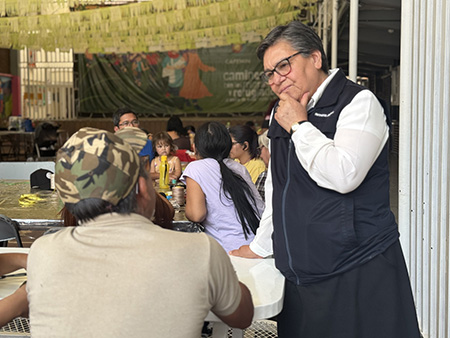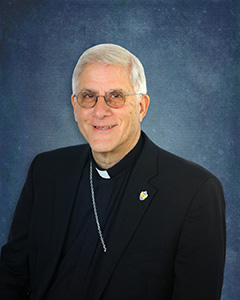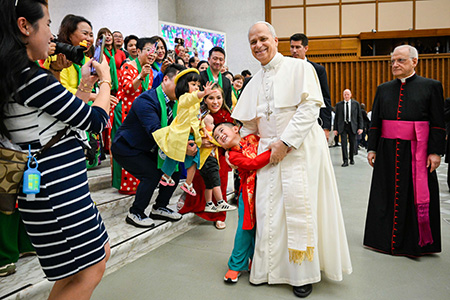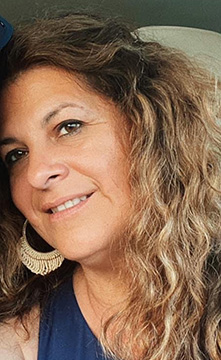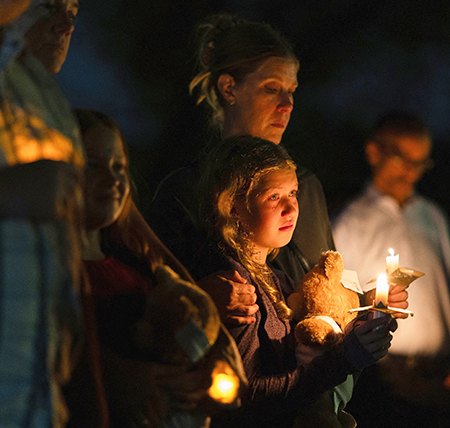By Maria Wiering , OSV News
MINNEAPOLIS (OSV News) — As the sun set the evening of Aug. 28, mourners lingered in front of Annunciation Catholic Church before a robust memorial of flowers, stuffed animals, toys and candles.
Visitors of all ages wrote messages on large pads of paper, others in chalk on the sidewalk.
“Our hearts with you,” read one.
“You are in my prayers,” read another.
A third: “There will be a day with no more pain or suffering. Hold onto Jesus’s hand until that day. He’s got you.”
Since the morning, parishioners and school families, neighbors and others had come to the church, many with bouquets, some cut from their own late-summer gardens, all aiming to express solidarity with a Catholic community grieving the loss of life, health and sense of security in the aftermath of a school shooting.
“Your mind just can’t leave those parents who lost kids,” said Megan Kirchner, 40, who tearfully walked around the church exterior in the waning light with her partner and three children.
That afternoon, the father of a slain child, 8-year-old Fletcher Merkel, stood before the memorial to address the community. Jesse Merkel recalled his son as a boy who loved family, fishing, cooking and sports.
“Please remember Fletcher for the person he was and not the act that ended his life,” said Merkel, with the hand of Annunciation Catholic School Principal Matt DeBoer on his shoulder. “We love you, Fletcher. You will always be with us.”
Fletcher was one of two students killed in church pews Aug. 27 when a shooter fired with three guns through the church’s exterior windows into an all-school Mass. The other student was 10-year-old Harper Moyski, whose parents recalled her as “bright, joyful and deeply loved.”
Eighteen others — 15 children and three adults in their 80s — were also injured and treated at nearby hospitals. On Aug. 28, one victim remained in critical condition, with two others in serious condition, according to the emergency medical team at Hennepin County Medical Center, a Level 1 trauma center in downtown Minneapolis.
The 23-year-old suspected shooter died of a self-inflicted gunshot wound in the church’s parking lot, according to law enforcement, who were working to pinpoint a clear motive for the act of violence.
Boards covered seven of Annunciation’s narrow stained-glass windows, behind another memorial set against a young oak tree.
“Just words don’t work any more,” read a sign tucked into clusters of hydrangeas, sunflowers and roses.
The memorial was a spontaneous response for a reeling community, one frequently described as “tight-knit” — both as a parish and preK-8 school, and also as a neighborhood, where many school families live within walking distance.
Or running distance — as evidenced by how many parents literally ran to the school when they heard of the shooting, which occurred around 8:30 a.m., as Mass attendees were preparing to sing the “Alleluia.”
Father Erich Rutten witnessed those parents rushing on foot to the school as he followed a barrage of police cars to the church that morning. The pastor of two nearby parishes and chaplain of their shared elementary school, Father Rutten happened to be driving through the neighborhood and stopped, without knowing what had transpired, to provide pastoral assistance at Annunciation — a parish where he had served on staff decades ago, before entering seminary.
When he arrived on the scene, parents did not “know if their child was alive or dead,” he said. “They’re just panicked and scared.”
For 45 minutes, he tried to offer support to parents, especially those who appeared to be alone, and prayed the rosary with some of them. Ultimately, he spent almost three hours at the parish, and was with one family as they were informed their child had died.
“Just that kind of the bottom-of-your-soul scream of despair — that was really, really awful. Awful,” he said.
Father Rutten recalled the previous day’s events following an evening ecumenical prayer service Aug. 28 at the Basilica of St. Mary in Minneapolis. The service drew a range of Minneapolis religious leaders as well as hundreds of mourners who filled the Archdiocese of St. Paul and Minneapolis’ co-cathedral.
Among them were Mary Perez, 32, and her son, Felix, a first-grader at Annunciation who had been at the all-school Mass and witnessed students shot and injured. Mary brought Felix to the prayer service so he could find comfort in the community’s support.
“I thought it’d be important for Felix to know that he’s not alone in this, that this is a safe place,” said Mary, a Catholic. “We’re all going to come back from this, and he has people behind him, and I don’t want him to be afraid of the church.”
Six-year-old Felix said that he remembers “all of it,” especially how Principal DeBoer told the students to get down. Eighth-graders protected some of the younger students, Mary said.
“A friend of mine got hit in the forehead,” Felix told OSV News. “When I was hiding, I saw somebody covered in blood, and they were wearing a green sweatshirt covered in blood.”
Mary’s brother, 24-year-old Benjamin Bozer, wept next to his wife, Penny, as he heard his nephew recount the events.
“Growing up, I was always worried that it could happen to me; but the fact that it could happen to someone so young, it’s just senseless,” he said. “Nobody should have to go through this. Nobody should have to witness this.”
Annunciation parishioner and former teacher Janet Parker, whose now-grown children once attended the school, also attended the basilica’s prayer service.
“It’s so strange to see your community in the news framed this way,” she said. “It was numbing.”
Jiyun Kim, whose Korean Catholic St. Andrew Kim Parish has worshipped at Annunciation’s church since 2023, felt similarly. The 40-year-old brought her two children, ages 10 and 13, to visit Annunciation’s memorial the evening of Aug. 28.
While her children do not attend the school, their ages make her “feel really connected and related to what happened to the families and the community,” she said. “I couldn’t imagine how I’m going to feel during the Mass every weekend.”
Yet, she said, “when I see those flowers and the people crowded here, I feel we get stronger. We support each other, and that’s how our community heals each other. So when somebody falls, somebody will hold their hands, and then somebody will support their back. That’s how we make our community.”
The Twin Cities’ Catholic clergy have played an important role in supporting Annunciation’s families. St. Paul and Minneapolis Archbishop Bernard A. Hebda has repeatedly praised the response of Annunciation pastor Father Dennis Zehren, who became the parish’s pastor in June, as well as Deacon Kevin Conneely, who was ordained in 2023.
After ministering at Annunciation to families in the hours after the shooting, Father Rutten headed to Hennepin County Medical Center, where he sat in the waiting room with families. St. Paul and Minneapolis Auxiliary Bishop Kevin T. Kenney, who serves as pastor of a downtown Minneapolis church and grew up attending Annunciation, also headed to HCMC that morning, immediately after hearing the news of the shooting.
“I was there in the waiting room as families were rushing down there, and they didn’t know what state, what condition their child was in, so they’re all panicking,” he said.
He was “just trying to give them a presence, a calm presence, a supportive presence to know they were not alone,” he added.
Meanwhile, fellow Auxiliary Bishop Michael J. Izen was called to nearby Children’s Minnesota Hospital to offer anointing of the sick to an injured Annunciation student.
In responding to a tragedy, “there’s always an initial, ‘What am I going to say? What can I do?’ And then you realize that people are just comforted and pleased by your presence” as a priest, he said.
Across the Mississippi River in St. Paul, both bishops preached Aug. 28, along with Archbishop Hebda, at a noon prayer service at the Cathedral of St. Paul.
Bishop Izen addressed key questions on the minds of many Twin Cities Catholics, especially with the shooting having occurred during Mass.
“Where was Jesus yesterday? Where was Jesus at 8:30 in the morning at Annunciation?” he asked. “Why during a school Mass? Why an 8-year-old and a 10-year-old? Why right here in the Twin Cities?”
“There’s no shortage of questions, but only one answer: Jesus Christ,” he said.
“Where was Jesus during that time, during the Mass, the shooting? He was right there on the cross suffering with them,” he said. “The Lord always wants us, in those times of suffering, to turn to the cross. So turn to our Lord. Go to Jesus.”
(Maria Wiering is senior writer for OSV News.)

